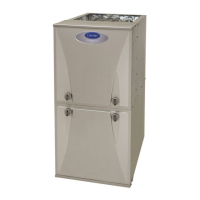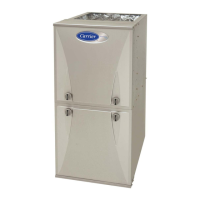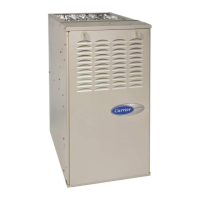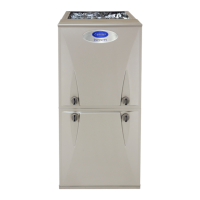PG96MSA: Installation, Start-up, Operating and Service and Maintenance Instructions
Manufacturer reserves the right to change, at any time, specifications and designs without notice and without obligations.
46
mark. Quickly apply approved cement to end of pipe and fitting
socket (over primer). Apply cement in a light, uniform coat on
inside of socket to prevent buildup of excess cement. Apply second
coat. DO NOT CEMENT POLYPROPYLENE FITTINGS.
14. While cement is still wet, twist pipe into socket with 1/4-in. turn.
Be sure pipe is fully inserted into fitting socket.
15. Wipe excess cement from joint. A continuous bead of cement will
be visible around perimeter of a properly made joint.
16. Handle pipe joints carefully until cement sets.
17. Horizontal portions of the venting system shall be supported to
prevent sagging. Space combustion air piping and vent piping
hangers as shown in Table 17. Support pipes using perforated metal
hanging strap or commercially available hangers or straps designed
to support plastic pipe.
Table 17 – Hanger Spacing
18. Slope the vent and combustion air piping downward towards
furnace. A minimum slope of at least 1/4-in. (6 mm) per linear
ft.(1-in (25 mm) per 4 ft.(1.2 M)) with no sags between hangers is
required. See Caution Box below.
19. Use appropriate methods to seal openings where combustion air
pipe and vent pipe pass through roof or sidewall.
Installing the Vent Termination
Roof Terminations
A roof termination of any type will require a 4-in. (102 mm) flashing for
a 2 in. (50 mm ND) concentric vent kit, KGAVT0701CVT or a 5-in.
diameter (127 mm) flashing for a 3-in. (80 mm ND) concentric vent kit,
KGAVT0801CVT. For two-pipe or single pipe vent systems, a flashing
for each pipe of the required diameter will be necessary.
It is recommended that the flashing be installed by a roofer or competent
professional prior to installing the concentric vent. The terminations can
be installed on a flat or pitched roof.
Concentric Vent
Single or multiple concentric vent must be installed as shown in Fig. 39.
Maintain the required separation distance between vents or pairs of vents
as shown in Fig. 39 and all clearance shown in Fig. 42.
NOTE: Follow the instructions of the vent terminal manufacturer.
These instructions are provided as a reference, only.
Cut one 4-in. (102 mm) diameter hole for 2-in. (50 mm ND) kit, or one
5-in. (127 mm) diameter hole for 3-in. (80 mm ND) kit in the desired
location.
Loosely assemble concentric vent/combustion air termination
components together using instructions in kit.
Slide assembled kit with rain shield REMOVED through hole in wall or
roof flashing.
NOTE: Do not allow insulation or other materials to accumulate inside
of pipe assembly when installing it through hole.
Disassemble loose pipe fittings. Clean and cement using same
procedures as used for system piping. DO NOT CEMENT
POLYPROPYLENE FITTINGS.
Two-Pipe and Single-Pipe Terminations
Single and two pipe vent must be installed as shown in Fig. 39 and
Fig. 40. Maintain the required separation distance between vents or pairs
of vents as shown in Fig. 39 and Fig. 40 and all clearance shown in
Fig. 42 and Fig. 43.
Cut the required number of holes in the roof or sidewall for vent and
(when used) combustion air pipes. Sidewall holes for two-pipe vent
terminations should be side-by-side, allowing space between the pipes
for the elbows to fit on the pipes.
Holes in the roof for direct-vent two-pipe terminations should be spaced
no more than 18 in. (457 mm) apart to help avoid vent gas recirculation
into combustion air intake.
Termination elbows will be installed after the vent and (if used)
combustion air pipe is installed.
Sidewall Terminations
Concentric Vent
NOTE: Follow the instructions of the vent terminal manufacturer.
These instructions are provided as a reference only.
Determine an appropriate location for termination kit using the
guidelines provided in section “Locating The Vent Termination” in
this instruction.
1. Cut one 4-in. diameter hole for 2-in. kit, or one 5-in. diameter hole
for 3-in. kit.
2. Loosely assemble concentric vent/combustion air termination
components together using instructions in kit.
3. Slide assembled kit with rain shield REMOVED through hole.
NOTE: Do not allow insulation or other materials to accumulate inside
of pipe assembly when installing it through hole.
Diameter
Material
PVC Sch
40
SDR 21 &
26
ABS CPVC
Polypro-
pylene
1 1/2-in. 3-ft. 2 1/2-ft. 3-ft. 3-ft. 3.25-ft.
38-mm 914-mm 762-mm 914-mm 914-mm 1000 mm
2-in. 3-ft. 3-ft. 3-ft. 3-ft. 3.25-ft.
51-mm 914-mm 914-mm 914-mm 914-mm 1000 mm
2 1/2-in. 3 1/2-ft. 3-ft. 3 1/2-ft. 3 1/2-ft. 3.25-ft.
64-mm 1067-mm 914-mm 1067-mm 1067-mm 1000 mm
3-in. 3 1/2-ft. 3-ft. 3 1/2-ft. 3 1/2-ft. 3.25-ft.
76-mm 1067-mm 914-mm 1067-mm 1067-mm 1000 mm
4-in. 4-ft. 3 1/2-ft. 4-ft. 4-ft. 3.25-ft.
CAUTION
!
FURNACE RELIABILITY HAZARD
Failure to follow this caution may result in nuisance short cycling,
frozen vent termination, and/or no heat.
Slope the vent and combustion air piping downward towards furnace a
minimum of 1/4-in. (6 mm) per linear ft. of pipe.
WARNING
!
CARBON MONOXIDE POISONING HAZARD
Failure to follow this warning could result in personal injury or death.
DO NOT use cement to join polypropylene venting systems. Follow
the polypropylene venting system manufacturer’s instructions for
installing polypropylene venting systems.
NOTICE
!
FOR POLYPROPYLENE VENTING SYSTEMS
When using polypropylene venting systems, all venting materials used,
including the vent terminations, must be from the same manufacturer.
NOTICE
!
RECOMMENDED SUPPORT FOR VENT TERMINATIONS
It is recommended that rooftop vent terminations in excess of 36 inches
(1 M) in vertical length be supported by EITHER the Direct Vent
Termination Kit shown in Table 12 or by field-supplied brackets or
supports fastened to the structure.

